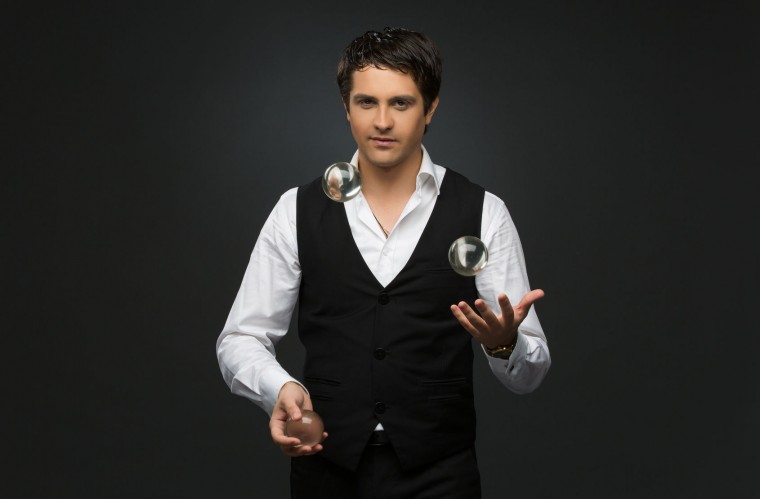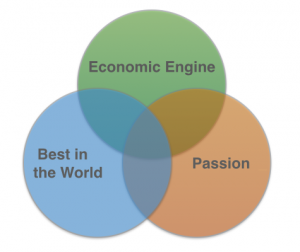Oct 13, 2014
Oct 13, 2014

Posts and resources related to personal strategy, personal development, and the discipline to get things done.

“This task is a priority” is a phrase we hear, and say, all the time. But what does that truly mean?
When used as an adjective like this, it indicates that whatever we are talking about is taking precedence over something else. We might say something like “this is my highest priority”, but more often say “I have these priorities”. Over time the meaning has softened… ‘taking priority’ simply means ‘ahead of something else’. Trying to decide what to do next might look like this:
Key Project > Email > Family Time > Facebook > Sleep > Exercise > Food prep > Breaking Bad > Twitter > etc.
Each thing in the list has priority over the thing after it. So in this example, exercise ‘is a priority’ over watching Breaking Bad (not all of you will agree) and both of those are at the end of a long list of other tasks. Its no wonder that this word has softened to the point that it isn’t all that useful. We can execute on ‘our priorities’ all day long, and still not make any real progress.
I find myself doing this all the time. I have a list of tasks - priorities - all of which really need to be done. If I tackle them depending on their urgency, I’ve often wasted my most valuable time. Inevitably the thing that gets pushed to another day is the one that requires the most focus and attention but isn’t urgent. (Quadrant 2 for my Time Management Students)
Bad news! - this is often the one that would have had the biggest impact. It is usually important, but not urgent.
Instead lets consider the word PRIME. As an adjective prime means of the first importance; demanding the fullest consideration.
One of the things that helps me to get things done is that instead of asking myself “what are my priorities today?” I try to decide what my “prime” is for the day. This idea is all over the place in the personal productivity literature, most recently in a great book by Gary Keller called The One Thing. It is also mirrored in The 4 Disciplines of Execution by Chris McChesney and others. Both of these authors recommend finding something to focus on at the exclusion of all the other things that might pull us away from our most important task.
Try this experiment. Ask yourself:
What is the one thing that I could do today, that if I got it done with excellence, would make everything else either easier or irrelevant?
then do that first! Make it PRIME. Don’t open your email, ban Facebook and twitter… don’t let distraction in. Focus on your prime task until that task is done… then everything else will be easier or irrelevant.
I hope you have a prime day.

Ever heard about the 1953 study on goals where only 3% of Yale students had specific written goals for their future? 20 years later that group was earning 10 times more than their other classmates. I must have heard about this study a dozen times - its made the motivational speaker circuit for years… even just yesterday I was listening to Darren Hardy say that by writing down my goals I’m joining the top 3%. The only problem - this study never happened!
Setting goals is the first step in turning the invisible into the visible. - Tony Robbins
Don’t despair though, a researcher named Dr. Gail Matthews from the Dominican University in California set out to find out whether writing down our goals actually matters. Matthews recruited 267 participants from a variety of countries, occupations and ages. They were randomly assigned to one of 5 groups.
The participants were asked to rate their progress and how effectively they had achieved their goals. While group 1 only achieved 43% of their goals, group 5 achieved 76%. It is worth noting that while writing down goals gave the participants an initial bump from 43% to 64%, there wasn’t much difference added by writing down action steps or even sending the goals to a friend. The next big jump came with adding a weekly accountability task.
Accountability breeds response-ability. - Stephen Covey
If you want to achieve your goals you should:
Simply by taking these steps you’ve dramatically improved the chances you will reach your goals.
If you go to work on your goals, your goals will go to work on you. If you go to work on your plan, your plan will go to work on you. Whatever good things we build end up building us. - Jim Rohn

Highly successful people, especially entrepreneurs like private practice owners, often take their work life to extremes. They push well beyond a typical work day or work week at the expense of family and relationships. For these people (I might as well say my people), Gary Keller, author of The ONE Thing recommends counterbalancing. In other words - taking the same approach with leisure time that you take with your work life.
If you are going to work extreme hours… you need to spend some extreme time in rest and recuperation mode as well. If you don’t push your life out of balance, you might get away with a typical work week and relaxing on the weekend… taking the 60-70% of your allotted paid time off each year as many Americans do. For those of us that push hard for long periods of time, failing to counterbalance can lead to big health, relationship and even professional problems.
While our personal rhythm of push and counterbalance might work for us, we often expect the people in their lives to accept the same sort of rhythm. The challenge is that most relationships don’t do well with extremes. If you check out emotionally and don’t focus on your family for a month or two while you are pushing on a work goal, you should not expect everything to be great after a little counterbalancing with a family vacation. Relationships – and particularly spouses and children, require counterbalancing with much greater frequency.
A frequently cited metaphor in the literature around work/life balance comes to us from Bryan Dyson, then CEO of Coca-cola in his mid ‘90s commencement speech at Georgia Tech. He says:
Imagine life as a game in which you are juggling some five balls in the air. You name them - work, family, health, friends and spirit - and you’re keeping all of these in the air. You will soon understand that work is a rubber ball. If you drop it, it will bounce back. But the other four balls - family, health, friends and spirit - are made of glass. If you drop one of these, they will be irrevocably scuffed, marked, nicked, damaged or even shattered. They will never be the same. You must understand that and strive for balance in your life.
Similarly, counterbalancing with diet and exercise just plain doesn’t work. Ever tried pigging out and avoiding exercise for a few months and then trying to get back in shape with a few weeks of eating healthy and exercising? Health requires daily attention… going to extremes doesn’t work.
Failing to counterbalance the stress and fatigue from pushing toward our career goals leads us to begin to pull attention away from the daily and weekly rhythm of relationships and the habits that lead to health, energy and longevity.
Keeping the habits and rhythms of diet and exercise, family and relationships, church and spiritual life (the glass balls) provides us with the resilience we need to launch our professional rubber ball as hard and as fast as we can.
Which ‘ball’ do you tend to have trouble keeping track of?

Before I left for physical therapy school, I had one great fear: no matter how hard I tried, I was going to be a bad PT. I confided this fear to a mentor of mine, a well-respected PT himself. His response is one I’ve thought about regularly since that day- that with a solid foundation in school and good mentorship afterwards, there was no doubt I would be a great PT.
Having now completed my education and practiced for a year, I realized that my mentor’s comments ring true for not just me, but for anyone entering the profession.With a new cohort of freshly licensed PT’s and PTA’s coming in to the profession, I took some time to reflect upon the major lessons I have learned over my first year in practice. The below points have resonated with me most, but please feel free to add your own in the comments section below!
1. Mentorship is made by you, not provided by someone else. When interviewing for jobs, we all hear promises of weekly mentorship time and guided learning. Yet, if you do not prioritize this time, it’s likely to get lost in the pressures of the day. It’s our responsibility to make sure our mentorship time actually happens and is effectively used. Here are a few practices I have found helpful: a) block off your mentor time on your schedule- it’s simple, but makes the time more official; b) make sure your mentor is someone who you want to learn from; c) plan it out- set individual goals for yourself each time you meet with your mentor.
2. Don’t compromise your values. Coming out of school, the lines between right and wrong seem pretty clear. However, those lines may quickly blur by pressures to bill more units, see more patients, or take on a practice outside of your ethical comfort zone. Remember that these decisions are ultimately in your hands- it’s your license and happiness that’
s on the line by being in a job that challenges your morals, ethics, and ability to take quality care of your patients.
3. Develop self-management strategies and remember your role. Patient care is hard. And a lot of responsibility. While we may see 60 patients per week, our patients only see us once or twice. Many times, we are the only health professional caring for their well-being. Because of the time we spend with our patients and trusting relationships we develop, many patients often end up airing all of their concerns to us. We may not be trained as social workers or psychologists, but the nature of our job demands we play a role as a quasi director of their care. There’s no doubt about it- doing this for patient after patient is mentally, physically, and emotionally draining. In response to this fatigue, I’ve developed a couple strategies to make my day more manageable. First and foremost, I always try to remember my role- we don’t have the time or training to be everything to everyone, so I make sure to refer to other professionals when appropriate, even when it means embarking on a difficult conversation. Second, I try to take 2-3 minutes between patients to decompress. Just a few minutes allows me to refresh, knock out a bit of documentation, and ensure I approach the next patient as a clean slate. I find I can bring more to the treatment session with those couple minutes to myself, even if it means I’m slightly late to the next treatment session.
 4. Attitude is truly infectious. It’s easy to fall down the wormhole of complaining about patients or co-workers, but finding ways to stay positive, smile, and bring joy to the clinic is much more rewarding. We all have difficult days, but bringing a positive attitude to work can change the entire culture within a clinic. I challenge you to be that compassionate and empathetic person that brings positivity to a clinic. Once you do, your colleagues will start to look at you as a leader and your patients will notice.
4. Attitude is truly infectious. It’s easy to fall down the wormhole of complaining about patients or co-workers, but finding ways to stay positive, smile, and bring joy to the clinic is much more rewarding. We all have difficult days, but bringing a positive attitude to work can change the entire culture within a clinic. I challenge you to be that compassionate and empathetic person that brings positivity to a clinic. Once you do, your colleagues will start to look at you as a leader and your patients will notice.
5. Recognize your needs. Then verbalize and fight for them. Everyone has an idea of what it means to be successful, but only you know what you need to be successful. Too often, I see new employees try to conform to a system and environment that does not work for them. Whether you feel you need more mentorship, want to attend a continuing education course, or even would like something as simple as a slightly longer lunch, do not let a resentful feeling brew- approach your employer in a respectful fashion. Chances are that your employer is looking to support you, but does not see your needs. If your employer is not willing to acknowledge or support your needs, it might be time to consider a change.
6. Reflection really is important. Be a conscious practitioner. In PT school, our class reflected on everything. In fact, I’m pretty sure we reflected on our reflections. We reflected so much that reflection became a dirty word. However, I have come to find great power held within reflection. Make sure to periodically ask yourself, “what could I have done better during my last treatment session,” or “what could I improve upon from last week?” It’s easy to go through the motions, but approaching your treatment session consciously, by analyzing what you are doing, why you are doing it, and how you can improve will lead to greater growth and fulfillment.
7. It’s worth it. Patient care is challenging. Most days are exhausting. Yet, if you give it your all and fully engage with your patients, it can be extremely rewarding. The feeing you get when someone looks you in the eye, shakes your hand, and says a genuine ‘thank you for your help,’ is a feeling I have never reproduced elsewhere in the world. We play a special role in our patients’ lives, giving them our time, touch, and knowledge. Cherish your relationships with your patients and never forget what it feels like to help someone achieve their goals.
Any big lessons I missed? Please consider adding your own lessons to the list in the comments section below!
About the Guest Blogger: Josh D’Angelo, PT, DPT served as APTA Student Assembly President in 2013 and is now active with APTA’s DC Chapter and Private Practice Section. He graduated from George Washington University’s Doctorate of Physical Therapy program in 2013, where he was the University’s sole student to win the George Washington Award. Josh is also a former APTA Mary McMillan Scholarship awardee and is currently practicing in the outpatient orthopedic setting in Washington, D.C. He is a regular contributor at PTHaven.

Last weekend, I had the pleasure of listening to Diana Nyad speak at the 2014 TeamBeachBody Coach Summit. This amazing lady shared the story of her lifelong goal of swimming from Cuba to Florida, which she achieved at age 64. I vaguely remembered seeing this on the news last year, but I failed to realize just how impossible this swim is.
103 miles in the open ocean, through waters teeming with sharks and jellyfish. In the 30 years since she failed the first time (still setting a world record by swimming to the Bahamas instead) nobody had broken her record. To be honest, part of me thought that wanting to do this in the first place must be a special kind of insanity. Then she said this:
It’s not about what you get, it’s about who you become
This really struck me. What if I could apply the mindset of arguably the world’s toughest athlete to my own life and endeavors?
Its easy for me to stay in my comfort zone and to complete my daily work without ever really stretching myself. I’ve always wanted to write a book. Its a scary proposition, though… what if nobody wanted to read it? What if I put all that work into it and then it didn’t go anywhere? Its always seemed like an impossible goal.
Diana told us that achieving her goal wasn’t what made the difference… striving for the goal defined her, fulfilled her and allowed her to build a tremendous resilience. She failed and failed and failed until she finally succeeded. The most important thing she did was to try.
I think I’ll take that little quote, put it in my journal and try to be a person that fails at massive goals. After all, that’s exactly who Diana was when she started her fifth and final try at that impossible swim.
Do you have an impossible goal?

One of the most elegant and useful concepts from Jim Collins’ Good to Great study is the Hedgehog Concept.
The Fox knows many things, but the hedgehog knows one big thing - Archilochus
In his famous essay “The Hedgehog and the Fox“, Isaiah Berlin divides people into two groups: foxes that see the world in all its complexity and pursue many ends at the same time vs. hedgehogs that condense concepts and reduce challenges into simpler ideas. The parable would have the crafty fox attack the hedgehog with a variety of clever strategies, to be repeatedly beaten by the hedgehog’s simple, but powerful strategy - roll into a ball so the pointy parts are facing out. While the fox is crafty and nimble, the hedgehog is focused, determined and stays the course.
The companies that went from good to great discovered and then had the discipline to stay within a foundational hedgehog concept that kept them from being distracted from their core business. In contrast, the comparison companies that never made the leap to greatness often lost focus and took opportunities that were outside of their strengths.
A hedgehog concept is found at the intersection of three dimensions:

The good to great companies (compared to comparison companies) were disciplined enough to understand and stick to their Hedgehog concept despite the temptation to chase after increased profits or ‘once in a lifetime opportunities’.
In the medical field we see some great examples of finding and sticking to a hedgehog concept. One local example is a practice called Sullivan Physical Therapy. This practice has a niche - women’s health - that they are great at. Another is Balance 360 that focuses on balance and vestibular disorders. In these cases, these practices don’t try to be all things to all people - they have a concept that they can be the best at, that drives their economic engine and that they are passionate about.
I don’t think that the hedgehog concept applies only to practice niches, though. At Texas Physical Therapy Specialists, we can be the best in the world at developing clinical specialists and team leaders. This is where our passion lies and the team it produces drives our economic engine. By understanding and sticking to our hedgehog concept, we have the potential to be the best in the world. We have to have the discipline to avoid ‘once in a lifetime opportunities’ that don’t fit within our concept and we have to have the discipline to stay the course when it seems like jumping to a different strategy might be more effective.
What’s yours?

Steve Jobs had a penchant for dreaming big. His far-reaching vision brought personal computers into the home, revolutionized the music industry and contributed to the advent of today’s world of cloud computing. Yet at the same time, he also kept his hands in the nitty-gritty details of the products Apple was producing. He set not only the destination of Apple, but he paid attention to every turn along the way. This ability to ‘zoom out’ to the big picture and ‘zoom in’ to focus on details is part of what made him so effective.
Small business owners, particularly in service industries like physical therapy, are often pulled in a thousand directions. We have to make decisions on a grand scale - ‘Do I buy this building?’, ‘How big do I want to grow?’, ‘should I participate in this ACO?’. However, we also have an overwhelming flood of details to oversee. ‘who has the best price on theraband?’, do I have time to put another patient in my 2:30 slot?, ‘should I give my technician a $.25 raise?’.
“Details matter, it’s worth waiting to get it right.” - Steve Jobs
Focusing in on just the big picture can create problems. In today’s challenging payment environment, the margin is often found in our management of expense details and avoiding unnecessary costs. It takes almost $1.25 of revenue growth to equal $1.00 of cost savings. This means that controlling costs is often an underutilized mechanism for improving performance. The success of our teams often also happens due to paying attention to details. Getting the right people on the bus and making sure that we only tolerate A players has everything to do with careful selection of every member of our team.
However, focusing only on the details stifles innovation. Strategic thinking, big picture goal setting and innovation are necessary ingredients for a vibrant culture and practice growth. We have to have a vision and a strategic plan for reaching that vision. As Vince Lombardi said “hope is not a strategy.” As leaders in healthcare, we have to be part of the nationwide conversation going on right now. We need to be involved in coming up with the ideas that guide our changing healthcare system, and we will need to be ready to adapt to the new reality that is coming.
“I want to put a ding in the Universe” - Steve Jobs
To grow and to be successful we have to know both the big picture and the details.
This Jobs Applied lesson reminds me of one of my favorite principles from Jim Collins. My next #Browdering series will apply this principle and several others from ‘Good to Great’, ‘Great by Choice’ and ‘How the Mighty Fall’ to our world of physical therapy management and leadership. I hope you will join me next week as we discuss ‘The Stockdale Paradox’.
“Only through focus can you do world-class things, no matter how capable you are.”

Proposed by a Hungarian positive psychologist named Mihály Csíkszentmihályi, flow is the mental state of operation in which a person performing an activity is ‘fully immersed in a feeling of energized focus, full involvement, and enjoyment in the process of the activity’.
I am almost certain that if I couldn’t get into a state of flow while performing patient care, I wouldn’t be a physical therapist. Its also one of the reasons why I enjoy being engaged in a busy clinical setting, with just enough patients to where I can flow from one to the next with just enough time to get mandatory documentation and such accomplished.

This is so much more enjoyable than a slow day that drags on and on, or a day that is so hectic that I can never catch up. When I get just the right amount of patients scheduled and making great progress on their goals, time seems to disappear. I’m in control and the day feels like a dance put together by a master choreographer. That is flow.
You have to be involved in an activity with a clear set of goals and visible progress. This adds direction and structure to the task.There are three conditions that flow theory postulates have to be met in order to achieve flow:
Clinical practice can often meet all of these requirements when we are fully present and engaged. One of the ways I get into flow during a busy clinic day is by avoiding email, facebook and other distractions. I put my electronic medical record system in full screen mode and avoid the temptation to ‘check in’. This by itself doesn’t create flow state, but one thing is certain - you can’t flow while you are distracted.
Patient care lends itself to meeting the requirements for flow. We often see changes and make improvements immediately when working with patients. This gives us not only goals and visible progress, but immediate feedback.
We have the opportunity to make large improvements in patient’s lives, and we definitely have the capacity to make those changes. Few clinicians have the same opportunity to make immediate improvements and gain the reward of instant positive feedback. This is part of what makes physical therapy a highly sought after profession.
Check out this new interview I did with Paul Potter, PT. Paul interviewed me for his excellent Functional Freedom Podcast. We had a great conversation - I hope you enjoy it!